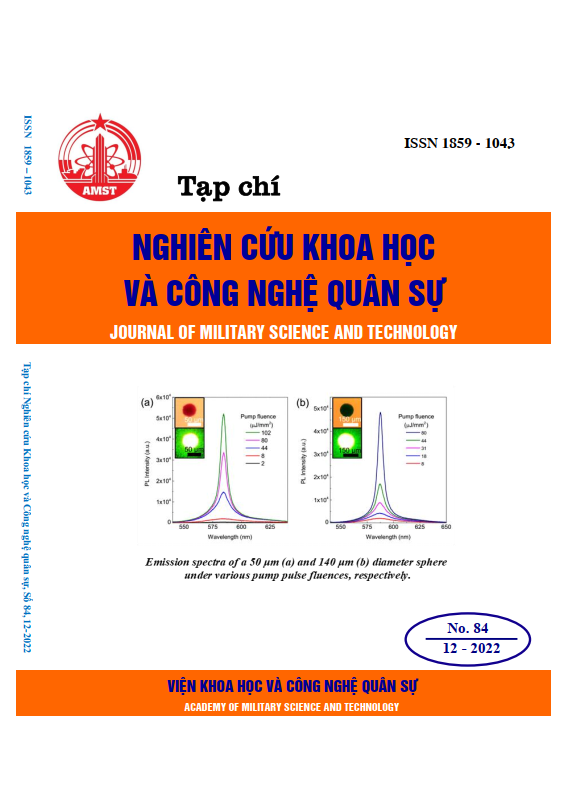Synthesis, optical properties and energy transfer in ZnO nanocrystals co-doped with Ce3+ and Tb3+ ions
521 viewsDOI:
https://doi.org/10.54939/1859-1043.j.mst.84.2022.101-108Keywords:
ZnO; Ce3 and Tb3 ions; Doped; Optical properties; Energy transfer.Abstract
ZnO nanocrystals (NCs) co-doped with Ce3+ and Tb3+ ions were successfully synthesized by Sol-Gel method. The presence and content of elements in the sample were determined through energy dispersive spectroscopy (EDX). The structure, crystal size of ZnO NCs co-doped with rare earth ions (RE) were investigated by using X-ray diffraction (XRD). The optical properties of ZnO NCs co-doped with Ce3+ and Tb3+ ions were investigated through excitation and fluorescence spectroscopy. The energy transfer process from Ce3+ ions to Tb3+ ions has been studied and explained in detail. The ZnO NCs co-doped with Ce3+ and Tb3+ ions are completely non-toxic and can can be controlled the optical properties by varying the Tb concentration. The results of this study show many possible applications of the material in the fields of lighting and biomarkers.
References
[1]. J. Guo, Y. Chen, Y. Zhang, Y. Xu, Y. Zhou, X. Zhang, X. Gao, “Shape-Dependent Linear Dichroism Spectra of Colloidal Semiconductor Nanocrystals”, Langmuir, Vol. 37, pp. 7611 - 7616, (2021). DOI: https://doi.org/10.1021/acs.langmuir.1c01155
[2]. L. Yanbing, Y. Yuan, N. Hu, N. Jin, D. Xu, R. Wu, H. Shen, O. Chen, L. S. Li, “Thick-Shell CdSe/ZnS/CdZnS/ZnS Core/Shell Quantum Dots for Quantitative Immunoassays”, ACS Applied Nano Materials, Vol. 4, pp. 2855 - 2865, (2021). DOI: https://doi.org/10.1021/acsanm.0c03483
[3]. J. Selvaraj, A. Mahesh, V. Asokan, V. Baskaralingam, A. Dhayalan, T. Paramasivam, “Phosphine-Free, Highly Emissive, Water-Soluble Mn:ZnSe/ZnS Core–Shell Nanorods: Synthesis, Characterization, and in Vitro Bioimaging of HEK293 and HeLa Cells”, ACS Applied Nano Materials, Vol. 1, pp. 371 - 383, (2018). DOI: https://doi.org/10.1021/acsanm.7b00218
[4]. J. Bera, A. Betal, A. Sharma, U. Shankar, A. K. Rath, S. Sahu, “CdSe Quantum Dot-Based Nanocomposites for Ultralow-Power Memristors”, ACS Appl. Nano Mater., Vol. 5, pp. 8502 - 8510, (2022). DOI: https://doi.org/10.1021/acsanm.2c01894
[5]. F. Costantino, L. Gavioli, P. V. Kamat, “A Bipolar CdS/Pd Photocatalytic Membrane for Selective Segregation of Reduction and Oxidation Processes”, ACS Physical Chemistry Au., Vol. 2, pp. 89 - 97, (2022). DOI: https://doi.org/10.1021/acsphyschemau.1c00035
[6]. M. Chhetri, P. V. Kamat, “Vectorial Charge Transfer across Bipolar Membrane Loaded with CdS and Au Nanoparticles”, The Journal of Physical Chemistry C, Vol. 125, pp. 6870 - 6876, (2021). DOI: https://doi.org/10.1021/acs.jpcc.1c00102
[7]. Y. C. Chen, T. C. Liu, Y. J. Hsu, “ZnSe·0.5N2H4 Hybrid Nanostructures: A Promising Alternative Photocatalyst for Solar Conversion”, ACS Applied Materials & Interfaces, Vol. 7, pp. 1616 - 1623, (2015). DOI: https://doi.org/10.1021/am507085u
[8]. C. N. Valdez, A. M. Schimpf, D. R. Gamelin, J. M. Mayer, “Proton-Controlled Reduction of ZnO Nanocrystals: Effects of Molecular Reductants, Cations, and Thermodynamic Limitations”, Journal of the American Chemical Society, Vol. 138, pp. 1377 - 1385, (2016). DOI: https://doi.org/10.1021/jacs.5b12182
[9]. S. Faisal, H. Jan, S. A. Shah, S. Shah, A. Khan, M. T. Akbar, M. Rizwan, F. Jan, Wajidullah, N. Akhtar, A. Khattak and S. Syed, “Green Synthesis of Zinc Oxide (ZnO) Nanoparticles Using Aqueous Fruit Extracts of Myristica fragrans: Their Characterizations and Biological and Environmental Applications”, ACS Omega, Vol. 6, pp. 9709 - 9722, (2021). DOI: https://doi.org/10.1021/acsomega.1c00310
[10]. S. Roy, S. Pramanik, S. Bhandari, A. Chattopadhyay, “Surface Complexed ZnO Quantum Dot for White Light Emission with Controllable Chromaticity and Color Temperature”, Langmuir, Vol. 33 , pp. 14627 - 14633, (2017). DOI: https://doi.org/10.1021/acs.langmuir.7b01738
[11]. P. M. Tan, N. X. Ca, N. T. Hien, H. T. Van, P. V. Do, L. D. Thanh, V. H. Yen, V. P. Tuyen, Y. Peng and P. T. Tho, “New insights on the energy transfer mechanisms of Eu-doped CdS quantum dots”, Phys. Chem. Chem. Phys., Vol. 22, pp. 6266 - 6274, (2020). DOI: https://doi.org/10.1039/C9CP06778G
[12]. N. T. Hien, N. X. Ca, N. T. Kien, N. T. Luyen, P. V. Do, L. D. Thanh, H. T. Van, S. Bharti, Y. Wang, N. T. M. Thuy, P. M. Tan, “Structural, optical properties, energy transfer mechanism and quantum cutting of Tb3+ doped ZnS quantum dots”, Journal of Physics and Chemistry of Solids, Vol. 147, pp. 109638, (2020). DOI: https://doi.org/10.1016/j.jpcs.2020.109638
[13]. N. T. Hien, Y. Y. Yu, K. C. Park, N. X. Ca, T. T. K. Chi, B. T. T. Hien, L. D. Thanh, P. V. Do, P. M. Tan, P. T. T. Ha, “Influence of Eu doping on the structural and optical properties of Zn1-xEuxSe quantum dots”, Journal of Physics and Chemistry of Solids, Vol. 148, pp. 109729, (2021). DOI: https://doi.org/10.1016/j.jpcs.2020.109729
[14]. N.X. Ca, N.D. Vinh, S. Bharti, P.M. Tan, N.T. Hien, V.X. Hoa, Y. Peng, P.V. Do, “Optical properties of Ce3+ and Tb3+ co-doped ZnS quantum dots”, Journal of Alloys and Compounds. Vol. 883, p. 160764, (2021). DOI: https://doi.org/10.1016/j.jallcom.2021.160764







